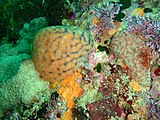The dive site Rheeder's Reef is an inshore rocky reef in the Storm's River Mouth area of the Tsitsikamma National Park, in the Eastern Cape province of South Africa.
Understand
editPosition
editDepth
editMaximum depth is about 21m. and the shallower areas are mostly about 16 m, but extend inshore as far as you can dive. This is not often shallower than about 8m, as the surge can be very strong, and it is usually more pleasant to stay a bit deeper.
Visibility
editVisibility is very variable, and ranges from less than 3 m to more than 20 m. 10 m would be considered good.
Topography
editExtensive relatively flat reef. Ridges run E-W with strike of sedimentary rock, probably sandstones and shales. Occasional sand patches. Dip very steep, near vertical.
Geology: Sedimentary rocks of the Table Mountain series, probably Ordovician sandstones of the Peninsula formation.. Strike approximately east-west, parallel with the shoreline cliffs, Dip very steep, near vertical.
Conditions
editThe site is exposed to wind and swell from the south east and south west, so should be dived when the swell is fairly low and particularly when the swell period is short. The site is reasonably protected from winds from the north west, but these usually accompany a cold front and south westerly swell will follow.
The site is usually at it's best in winter but there are also occasional opportunities at other times of the year. The site will probably be diveable in any conditions when it is safe to launch or recover a boat at the slipway, but this gives no indication of the visibility.
Get in
editAccess to this site is only by boat as the shore is a steep cliff. The site is about (distance)km from the Storm's River Mouth slipway
See
editMarine life
editVaries considerably with the topography: On the higher profile areas,there is quite heavy invertebrate turf with lots of sponges, gorgonian twig corals, colonial ascidians, False corals, and scattered anemones. Also sone Granular, Reticulated, Cobbled and Spiny starfish, brittle stars, feather stars, Cape urchins, fan hydroids, small whitish soft corals, nudibranchs, small barnacles etc. Fish include Blue Hottentot, Roman, Dageraad, Blacktail, Fransmadam, Koester, Steentjie, and shy sharks
- Orange lobed colonial ascidians
- Orange and blue fan ascidians
- Articulated coralline algal turf
- Reef assemblage
- Juvenile Slinger
- Sea fan
- Noble coral
- Basket star on sponge
- Invertebrate reef assemblage
- Cape dorid nudibranchs on a sponge
- Gas flame nudibranch
- Juvenile Koester
Photography
editGood site for photography, particularly close up and macro photography of invertebrates, but also providing opportunities to photograph the local reef fish, Visibility is variable, and the water is fairly deep, so an external flash is recommended for anything other than close-up work.
Routes
editNo particular routes recommended. Try to find an area where the ridges and gullies are relatively large as there is more to see and less bare rock.
Stay safe
editHazards
editNo site specific hazards known.
Skills
editNo special skills required. Good buoyancy control is helpful if there is a strong surge.
Equipment
editNo special equipment required. A DSMB will make it easier for the boat crew to find you if you do not surface on the shotline. A shotline is not particularly useful here for recreational dives, as the bottom is relatively flat. If the visibility is poor it will be dark, and a light will be useful to restore colour at depth.
Back to Diving the Tsitsikamma












